Evolution of Humans and Society – Prehistoric Period Notes 9th Social Science
Evolution of Humans and Society – Prehistoric Period Notes 9th Social Science
9th Social Science Lesson 1 Notes in English
1. Evolution of Humans and Society – Prehistoric Period
Tnpsc Syllabus Portion
Introduction
- We live in the age of Information Technology. The mobile phones have literally put the world on our finger tips.
- The allen compassing knowledge that we possess now, which has helped in the development of powerful technology, did not emerge all of a sudden.
- The foundation for our modern life was facilitated by the development of the process of cognition among the human ancestors in the prehistoric age.
- Prehistoric people were the pioneers of creative knowledge.
- From the artefacts and the languages they developed, we are able to understand how intelligent they were.
- Artefact is an object or tool made or modified by humans. Cognition refers to the act of mind in which knowledge and understanding are acquired through thoughts, experiences and senses.
- Cognition is related to development of human thought.
9th Social Book Back Questions
Origin of the Earth and the Geological Ages
- The history of humans is closely related to the history of the earth. The earth contains geological, archaeological and biological records of historical times in its upper layers.
- They are important for reconstructing the history of the earth and various living organisms.
- The fossil bones of the human ancestors are embedded in the earth’s layers.
- Palaeoanthropologists and archaeologists excavate the soil and rock layers on the earth and extract evidence about human ancestors.
- These layers and the fossils are scientifically dated to study the various stages in human evolution and prehistory.
- Through the gathered evidence, they attempt to understand the evolution of human history and developments in a chronological order.
- Archaeology is the study of human past through the analysis and interpretation of material remains.
- Palaeoanthropology is the study of the human ancestors and their evolution by the study of the fossil remains.
- The earth was formed approximately 4.54 billion years ago. Gradually, conditions emerged for the growth of organisms.
- Then plants and animals came into being, and thereby foundation was laid for the evolution of humans.
- The long span of time in earth’s history is divided into eras, periods and epochs by the geologists
- The earliest trace of life in the form of microorganisms emerged 3.5 billion years ago.
- The primitive multi-cellular form of life first appeared in the Proterozoic era, about 600 to 542 million years ago.
- In the Palaeozoic era (542 to 251 million years ago), fish and reptiles along with various plants appeared.
- Dinosaurs existed in the Mesozoic Era (251 to 66 million years ago). Australopithecines (literally ‘southern ape’) appeared in the Cenozoic era, which commenced about 66 million years ago.
- Australopithecines were the apes from which modern humans evolved. Now they are extinct, but they are considered to be the close relatives of humans.
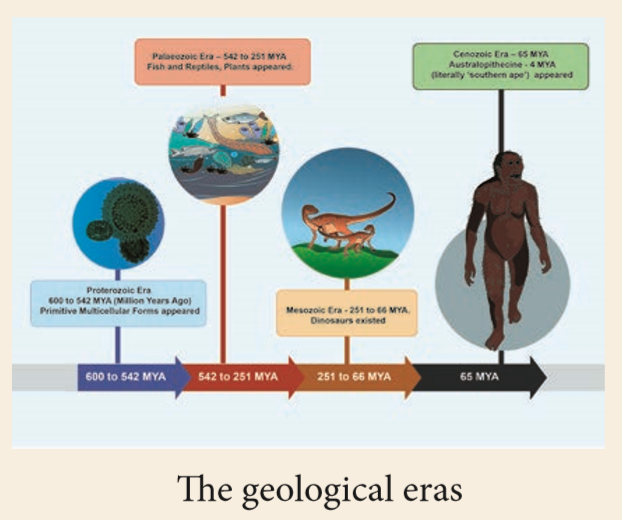
Human Enquiries into the Past and Origin of the World
The Age of Speculation
- Humans are the only species on earth concerned with understanding as well as explaining the world and the universe.
- In the course of evolution, humans became conscious and knowledgeable. They turned curious and began to think and ask questions about nature, organisms and the world around them.
- At first, they considered nature as God. They worshipped sun, moon and various natural forces about which they developed their own understanding, some of which is not scientific.
- The lack of scientific knowledge on the creation of the world is reflected in the ancient writings and religious literature.
BCE – Before Common Era CE – Common Era
Scientific Foundations of Geology, Biology and Archaeology
- The beginning of history writing can be traced to the ancient Greeks. Herodotus (484–425 BCE) is considered the Father of History, because the history he wrote was humanistic and rationalistic.
- In the Middle Ages, people were preoccupied with religion; but the real scientific enquiries became stronger only around the 15th and 16th centuries CE, with the Renaissance movement in Europe playing an influential role in rational thinking. Scientific enquiry was undertaken and scientific foundations for geology, biology, anthropology and archaeology were laid.
- Numerous ideas were articulated by various learned men in these fields during this period.
- Through their enquiry and observation, scholars believed that the evidence for the origin of the earth and the organisms lay in the upper layers of the earth.
- The rise of scientific enquiry into the origin of humans was possible because of
- the interest in collection of archaeological remains and the opening of museums after the Renaissance Movement;
- the development of ideas of stratigraphy and geology;
- Darwin’s theory of biological evolution;
- the discovery of human and animal fossils, stone tools, and artefacts of early civilizations; and
- the ability to decipher early scripts.
Stratigraphy
The study of origin, nature and relationships of rock and soil layers that were formed due to natural and cultural activities.
Oldest Museum
- The museum of EnnigaldiNanna in Mesopotamia was established in 530 BCE. The princess Ennigaldi was the daughter of the neo-Babylonian king Nabonidus.
- The Capitoline Museum in Italy is perhaps the oldest surviving museum (1471 CE) at present.
- Ashmolean Museum at Oxford University is the oldest university museum in the world. It was established in 1677 CE.
- Herbert Spencer’s (1820–1903 CE) and Charles Darwin’s (1809–1882 CE) theory on biological evolution, concepts of natural selection and survival of the fittest contributed to the scientific understanding of human origins.
- Charles Darwin published the books On the Origin of Species in 1859 and The Descent of Man in 1871.
Natural selection
- The processes by which organisms that are better adapted to their environment would survive and produce more offspring.
- Survival of the fittest means “survival of the form that will leave the most copies of itself in successive generations.”
Fossil
- Prehistoric animal or plant that turns into stone over a period of time (millions of years) because of chemical and physical processes.
- Animal bones are preserved due to mineralization. Palaeontology is the study of fossils.
- The idea of the Three Age System proposed by C.J. Thomsen became the basis for understanding early human history.
- He classified the artefacts in the Danish National Museum, Copenhagen, into Stone Age, Bronze Age and Iron Age.
Stone Age – the period when stone was mainly used for making implements.
Bronze Age – the period when bronze metallurgy (extraction of metal from ores) developed.
Iron Age – the period when iron was smelted to produce implements.
- Since the 19th century, scholars have used advanced scientific techniques and undertook systematic studies to contribute to the current state of knowledge on prehistory, human origins and the early civilisations.
- Now the theory of human evolution is widely accepted.
Prehistory: From Australopithecus through Homo erectus to Homo sapiens
- The introduction of writing system is a hallmark of the human civilisation.
- The period before the introduction of writing is called prehistory.
- Prehistoric societies are treated as pre-literate. But pre-literate should not be taken to mean primitive.
- The prehistoric people developed language, made beautiful paintings and artefacts, and they were highly skilful.
Human Evolution and Migration
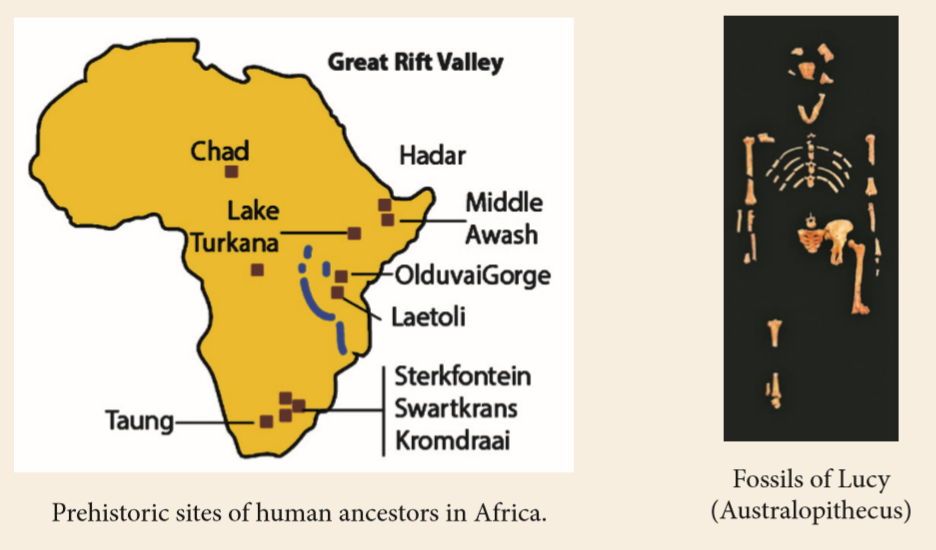
- The chimpanzee, gorillas and orangutans, along with humans, are collectively called the Great Apes.
- Among them, the chimpanzee is genetically the closest to humans. The ancestors to humans were called Hominins, and their origins have been traced to Africa.
- They evolved from those origins and then began to move to other parts of the world in due course of time.
- The Hominins emerged around 7 to 5 million years ago. Skeletons of Australopithecus, one of the early species of this tribe, have been found in Africa.
- The Great Rift Valley in Africa has many sites that have evidence for the prehistoric period.
- The Great Rift Valley is a valley like formation that runs for about 6,400 km from the northern part of Syria to Central Mozambique in East Africa.
- This geographical feature is visible even from the space, and many prehistoric sites are found in eastern Africa.
- Human ancestors are divided into various species according to their physical features. Hominid refers to all the species of the modern and extinct great apes, which also includes humans.
- Hominins (a zoological tribe) refers to the close relatives of human ancestors and their sister species including Homo sapiens (the modern humans) and the extinct members of Homo neanderthalensis, Homo erectus, Homo habilis and various species of Australopithecines.
- Humans are the only living species of this ‘tribe’. They stand erect, walk with two legs and have large brains.
- They can use tools and a few of them can communicate. It excludes the gorillas.
- Homo habilis (handy human) was the earliest known human ancestors to make tools in Africa about 2.6 million years ago.
- Around 2 million years ago, the species of Homo erectus/ergaster emerged. This species made hand axes between 2 and 1 million years ago.
- They began to spread into various parts of Asia and Africa in time. Anatomically, modern humans, called Homo sapiens (wise man), first appeared around 3,00,000 years ago in Africa.
- It is believed that these modern humans eventually migrated and dispersed into various parts of the world from around 60,000 years ago.
Prehistoric Cultures
While the fossil bones are classified as various species such as Homo habilis, Homo erectus and Neanderthalensis, based on the lithic tools, cultures are assigned names such as Earliest Lithic Assemblages, Oldowan Technology, Lower, Middle and Upper Palaeolithic and Mesolithic cultures.
Earliest Lithic Assemblages of Human Ancestors
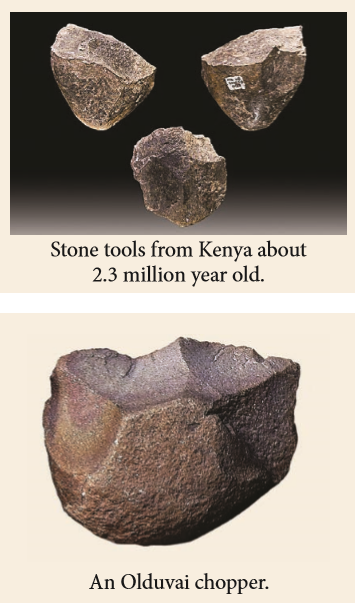
- The earliest tools made by human ancestors are found in Lomekwi in Kenya. They are dated to 3.3 million years.
- Oldowan tools occur in the Olduvai Gorge in Africa. They are 2 to 2.6 million years old.
- The human ancestors (Australopithecines) used hammer stones and produced sharp-edged flakes. The tools were used for cutting, slicing and processing food.
Lower Palaeolithic Culture
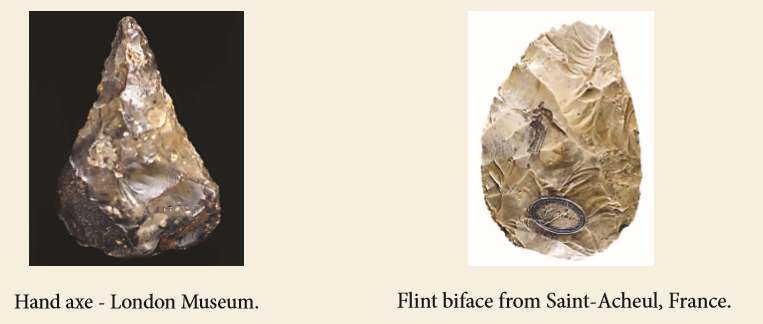
- The Lower Palaeolithic Culture is marked by the human ancestors belonging to the species Homo habilis and Homo erectus.
- The human ancestors flaked large stone blocks and designed various tools including hand axes.
- These tools, which are found in Africa, Asia, and Europe, are dated the earliest to about 1.8 million years ago.
- They made various tools such as hand axes and cleavers to meet their subsistence needs. These tools are also known as bifaces.
- These tools have physical symmetry and convey the humans’ cognitive (perception) skills. This culture is called the Lower Palaeolithic Culture.
- The hand axe tools are also known as Acheulian. This tool-making tradition continued till 250,000 years to 60,000 years ago in India.
- Acheulian – They were first hand axes recognized at a place called St. Acheul in France. Hence they are called Acheulian tools.
- Bifaces are tools that have flaking on both sides (bi = two, face = side).
- Subsistence necessities of prehistoric humans were mainly food and water. The human ancestors perhaps did not possess complex language skills we have now.
- They might have voiced a few sounds or words and possibly used sign language. They were intelligent enough to select stones as raw material and used the hammer stones to carefully flake the rocks and design tools for their needs.
- They hunted animals, fed on the meat of the animals killed by predators and gathered plant foods such as roots, nuts and fruits.
- In India, the Acheulian tools have been found near Chennai and many other sites such as Isampur in Karnataka and Bhimbetka in Madhya Pradesh.
- Raw material is the naturally available stone block or pebbles selected by humans for making tools.
- Since these stones produced flakes with sharp edges, they were selected for making stone tools.
- Core is the main block of stone from which small chips are flaked by using a hammer stone. Flake is a small chip removed from a large stone block called the core.
Middle Palaeolithic Culture

- After about 398000 years BCE, further changes took place in the lithic technology in Africa.
- The Homo erectus species existed during this period. Anatomically modern humans are said to have emerged around 3 lakh years ago.
Lithic Technology:
- ‘Lith’ means stone. The methods and techniques involved in the production of stone tools are called lithic technology.
- The hand axes turned out to be much attractive in design and many smaller tools were also produced.
- The core was prepared and then tools were made. Points and scrapers were used. Short blades were also produced.
- The lithic tool-making tradition of the Levalloisian belonged to this period. The tools made during this time are found in Europe and Central and western Asia.
- Levalloisian tools are the implements made after preparing the core. It was named after the town of Levallois in France.
- The Middle Palaeolithic Culture appeared between 3,85,000 and 1,98,000 years BCE ago in Europe and parts of western and South Asia.
- The tools that were made during this period were in use till about 28,000 BCE.
- The people of this period were called Neanderthals. They buried the dead people systematically.
- Perhaps they were the first human ancestors to mourn death properly and bury the dead.
Upper Palaeolithic Culture
- The cultural phase that succeeded the Middle Palaeolithic is called the Upper Palaeolithic phase.
- This period was marked by innovation in tool technology. Long blades and burins were produced during this time.
- People used different varieties of silica-rich raw materials in this phase. Numerous paintings and art objects were made. The diversity of artefacts suggests the improvement in cognitive skills and the development of languages.
- Microliths appeared in this phase. Burin is a stone-made chisel with a sharp cutting edge.
- The modern humans, who first appeared as a result of human evolution in the sub-Saharan Africa 300,000 years ago, began to move to various parts of Asia around 60,000 years ago.
- They probably replaced the earlier populations. In Europe, humans known as Cro-Magnons lived in this period.
- Horns and ivory were used for making tools and art works. Bone needles, fishhooks, harpoons and spears were also employed creatively.
- The humans of this time wore clothes and cooked food. The dead were placed in the burials with folded hands placed over their chest. Pendants and richly carved tools were also seen in use.
- Evidences from paintings, clay model sculptures and carvings are available. Images on stone and bone called Venus Statues were produced in Europe and in some parts of Asia.
- The Upper Palaeolithic Culture appeared about 60,000 years ago. It continued till about the beginning of the Holocene about 12,000 years ago, when the Ice Age ended.
- Some of the rock paintings of India are also dated to this period.
Ice Age
The period before 8,000 BCE when many parts of the world remained covered by ice sheets and snow.
Mesolithic Culture
- Mesolithic period is known as the Middle Stone Age, as it is placed between the Palaeolithic and Neolithic periods.
- People mainly used microlithic (small stone) tools during this period. These people were hunter-gatherers.
- With the global warming occurring after the Ice Age, they became highly mobile and occupied various ecozones.
- People of Mesolithic period widely employed microlithic technology. They made tiny artefacts that were less than 5 cm in size.
- They produced points, scrapers and arrowheads. They also used geometric tools such as lunates, triangles and trapezes. These tools were hafted onto wooden or bone handles and used. Microliths are stone artefacts of small size.
- The dating of the Mesolithic Culture varies across different parts of the world. It was pre-agricultural in certain areas.
- In northwest Europe, the people of this culture appeared between 8,000 and 3,000 years ago.
- In India, Mesolithic Culture emerged around 10,000 BCE and in Tamil Nadu it continued up to 1000 BCE, till the beginning of the Iron Age.
- Some of the rock paintings of India date to the Mesolithic Period.
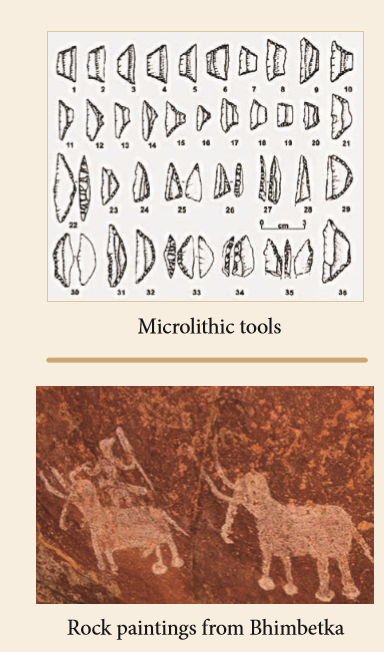
Neolithic Culture and the Beginning of Agriculture
- The period called Neolithic marks the beginning of agriculture and animal domestication. It is an important phase in history.
- Early evidence of the Neolithic period is found in the fertile crescent region of Egypt and Mesopotamia, the Indus region, the Gangetic valley and in China.
- By about 10,000 BCE to 5000 BCE, agriculture had come to be practised in these regions. Fertile Crescent Region refers to the area covering Egypt, Israel-Palestine, and Iraq, which is in the shape of crescent moon.
- Neolithic Age is called the ‘new age’, because of the new grinding and polishing techniques used for the tools.
- The Neolithic people also used the flaked stone tools. Until the Mesolithic period, people mainly hunted and gathered food for their subsistence.
- By hunting and gathering people obtained very limited food as a result of which only a small number of people could exist in a particular region.
- The introduction of domestication of animals and cultivating plants at home led to production and supply of large quantities of grains and animal food.
- The fertile soil deposited by the river on its banks helped the growth of agriculture. People preferred to live on river banks as it was better for adaptation.
- As a result of domestication and cultivating plants, there was an excess food production.
- The surplus food production was a main factor for the development of early civilisations. Permanent residences were built and large villages emerged as a result.
- Hence, the development of this period is called Neolithic Revolution.
Domestication of Animals and Plants:
- A Milestone in Human History Rice was probably cultivated in India and China around 7000 BCE or even earlier. Wheat and barley were cultivated at Mehrgarh in northwestern part of the Indian subcontinent (Pakistan) before 6000 BCE.
- Animal domestication developed as part of symbiotic life. Dogs may have been domesticated first. Friendly animals were gradually domesticated.
- Sheep and goat were domesticated around 10,000 BCE in Southwest Asia.
- Oxen were used in Sumerian civilisation for tilling the land. Mehrgarh in Pakistan has evidence of sheep, goat and cattle domestication in the Neolithic period
Prehistoric Tamilagam
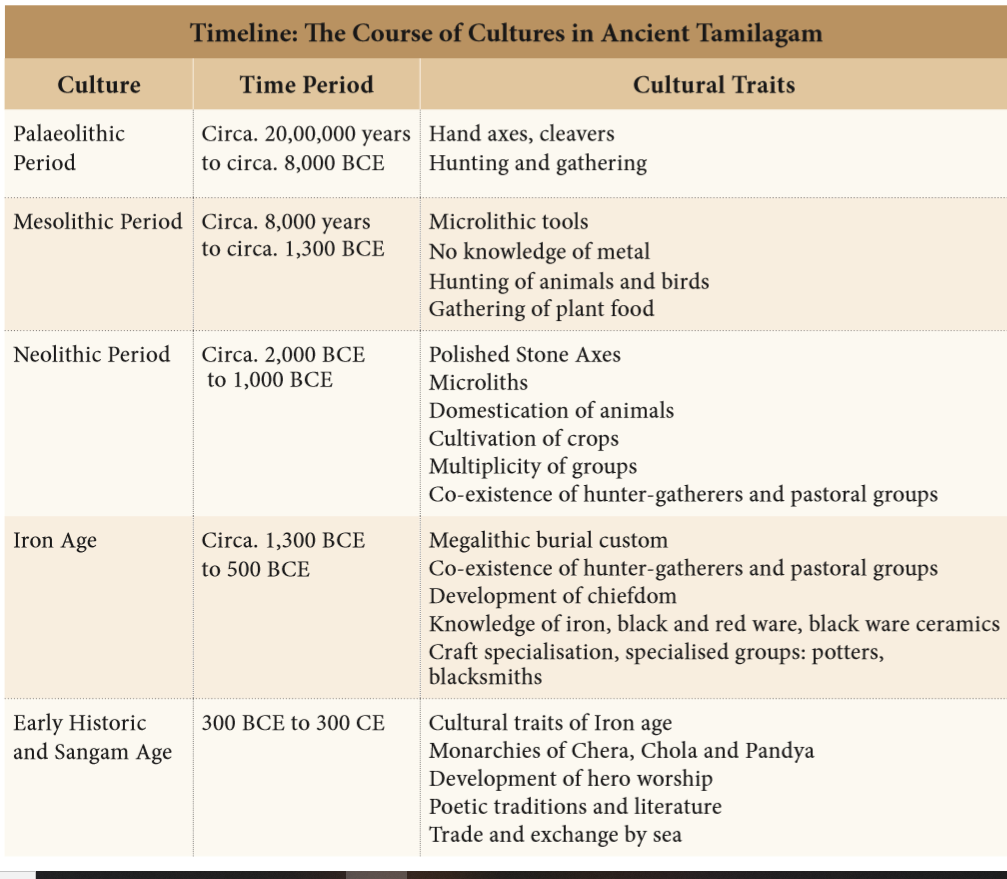
Background to Prehistory
Lower Palaeolithic Culture in Tamil Nadu
- One of the oldest Stone Age tools in the world made by human ancestors, called hominins, had been produced in Tamil Nadu.
- These stone tools are found near the Chennai region at several sites, especially at Athirampakkam.
- The archaeological excavations at this site and cosmic-ray exposure dating of the artefacts suggest that people lived here about 1.5 to 2 million years ago.
- The Kosasthalaiyar river is one of the major cradles of human ancestors in the world.
- The people who lived here belonged to the species of Homo erectus. Archaeological excavation refers to digging undertaken to recover archaeological evidence such as stone tools, pottery, animal bones and pollens, in order to understand the past lifestyle of humans.
- Cosmic-ray exposure dating – A method in which exposure to cosmogenic rays is done for dating the samples.
- In 1863, Sir Robert Bruce Foote, a geologist from England, first discovered Palaeolithic tools at Pallavaram near Chennai.
- They are the earliest finds of such tools in India. Hence, the hand axe assemblages were considered the Madras Stone Tool Industry.
- The tools that he discovered are now housed in the Chennai Museum. The Palaeolithic people hunted wild animals and gathered the naturally available fruits, roots, nuts and leaves.
- They did not have knowledge of iron and pottery making, which developed much later in history.
- Hand axes and cleavers are the important tool types of the Lower Palaeolithic period. These tools fitted with a wooden and bone handle were used for cutting, piercing and digging.
- The people of this time also used hammer stones and spheroids. The quartzite pebbles and cobbles were chosen as raw materials.
- The tools are found in the soil deposits and also in the exposed river side. They occur at Pallavaram, Gudiyam cave, Athirampakkam, Vadamadurai, Erumaivettipalayam and Parikulam.
Lemuria and the Tamils
- Some researchers relate the origin of the Tamils to the submerged continent of Lemuria. This theory of Lemuria continent was proposed in the 19th century.
- In the wake of advancements in plate tectonics theory, differing views are put forth by scholars.
- The available literary references point to the submergence of areas around Kanyakumari.
- Some parts of Sri Lanka and Tamil Nadu were connected by land about 5000 years BCE.
- It is possible that some land might have submerged near Kanyakumari and around the coast of India, because of the rising sea levels.
- Underwater surveys are necessary in this area. Archaeological research reveals that at least a section of people may have been living continuously in South India, including Tamil Nadu, from the Mesolithic and Neolithic times.
- The Lower Palaeolithic tools are also found in the North Arcot and Dharmapuri districts. The people belonging to this period used basalt rocks for manufacturing artefacts.
- However, the southern part of Tamil Nadu and Sri Lanka do not have evidence of Lower Palaeolithic Culture.
Basalt rocks are igneous rocks:
- Igneous rocks are those formed from the molten lava from the earth.
- The Lower Palaeolithic Culture is datable to about 2 – 1.5 million years at Athirampakkam.
- This cultural phase continued in other parts of India up to 300,000 years ago.
Middle Palaeolithic Culture in Tamil Nadu
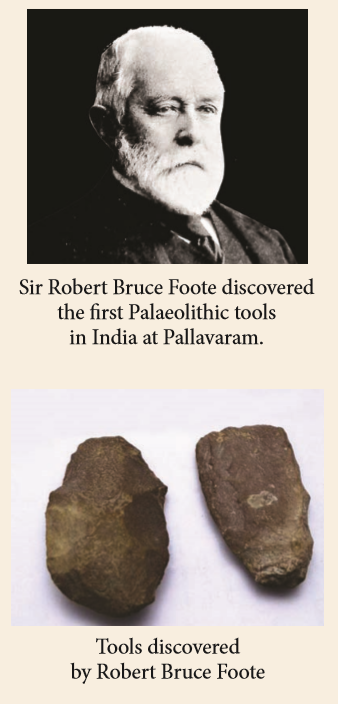
- In the course of time, the Middle Palaeolithic Culture emerged during 3,85,000 – 1,72,000 years ago.
- The tool types of this period underwent a change and smaller artefacts were used.
- Cores, flakes, scrapers, knives, borers, Levalloisian flakes, hand axes and cleavers are the artefact types of this period.
- Compared to the previous phase, these tool types became smaller in size.
- Evidence for the Middle Palaeolithic Culture can be observed in some parts of Tamil Nadu. In the southern part of Tamil Nadu, at T. Pudupatti and Sivarakkottai, artefacts of the Middle Palaeolithic tools have been collected.
- Also near Thanjavur and Ariyalur, similar artefacts have been found.
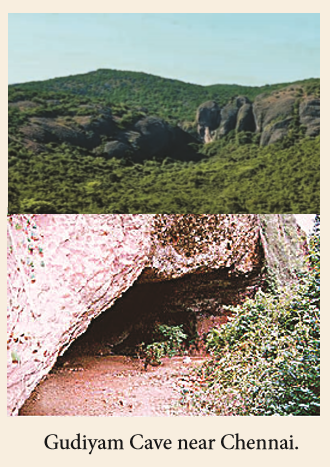
Mesolithic Culture in Tamil Nadu
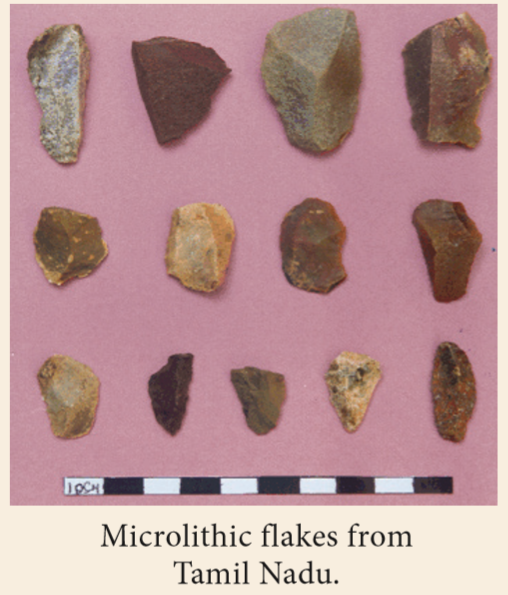
- In many parts of the world, and in some parts of India, the Upper Palaeolithic Culture succeeded the Middle Palaeolithic Culture.
- There is no evidence for the Upper Palaeolithic Culture in Tamil Nadu. But the people who used microliths or small-stone artefacts lived in many parts of Tamil Nadu.
- Since this cultural period occurs between Palaeolithic and Neolithic Culture, it is known as Mesolithic Culture or Middle Stone Age.
- Evidence for the existence of Mesolithic hunter-gatherers is found at Chennai, North Arcot, Dharmapuri, Salem, Coimbatore, Ariyalur, Tiruchirappalli, Pudukkottai, Madurai, Sivagangai, Tirunelveli and Kanyakumari.
- The teri sites near Thoothukudi have evidence of microlithic artefacts. These sites have red sand dunes called teris.
- Mesolithic people might have engaged in fi shing activities. Th e microlithic artefacts of southern Tamil Nadu are also found in the coastal regions of Sri Lanka.
- Geologists argue that the Tamil Nadu region and Sri Lanka remained connected before 5000 BCE when the sea level was low.
- The people of this period used small artefacts made of chert and quartz. The tool types are scrapers, lunates and triangles.
- These people hunted wild animals and gathered fruits, nuts and roots for their subsistence. Scrapers are tools used for scraping the surfaces.
- Scrapers are similar to the tools used in the kitchen for removing skin of vegetables. Triangles are tools in the shape of triangles.
- Lunates are tools in the shape of a crescent.
Neolithic Culture in Tamil Nadu
- The culture that domesticated animals and cultivated crops is called Neolithic. It is known as the New Stone Age. The Neolithic people used polished stone axes called celts.
- Cattle rearing was their main occupation. They lived in small villages with houses made of thatched roof and walls plastered with clay.
- Evidence of Neolithic village is found at Payyampalli in Vellore district and a few sites in the Dharmapuri region.
- Payyampalli is a village in Vellore district of Tamil Nadu. The earliest evidence for the domestication of animals and cultivation of plants is found at this site, which was excavated by the Archaeological Survey of India.
- Evidence for pottery making and cultivation of horse gram and green gram has been found in this village.
- These Neolithic sites were part of the Southern Neolithic Culture of India. They are mainly concentrated in the Andhra Pradesh and Karnataka regions.
- The Neolithic people used stone axes fitted on a wooden handle.
- These polished stone axes are worshipped in many village temples of Tamil Nadu even today used in the kitchen for removing skin of vegetables.
- Triangles are tools in the shape of triangles. Lunates are tools in the shape of a crescent.
Neolithic Culture in Tamil Nadu
- The culture that domesticated animals and cultivated crops is called Neolithic. It is known as the New Stone Age.
- The Neolithic people used polished stone axes called celts.
- Cattle rearing was their main occupation. They lived in small villages with houses made of thatched roof and walls plastered with clay.
- Evidence of Neolithic village is found at Payyampalli in Vellore district and a few sites in the Dharmapuri region.
- Payyampalli is a village in Vellore district of Tamil Nadu. The earliest evidence for the domestication of animals and cultivation of plants is found at this site, which was excavated by the Archaeological Survey of India.
- Evidence for pottery making and cultivation of horse gram and green gram has been found in this village. These Neolithic sites were part of the Southern Neolithic Culture of India.
- They are mainly concentrated in the Andhra Pradesh and Karnataka regions. The Neolithic people used stone axes fitted on a wooden handle.
- These polished stone axes are worshipped in many village temples of Tamil Nadu even today.
Iron Age / Megalithic period
- The cultural period that succeeded the Neolithic is called the Iron Age. As the name suggests, people used iron technology. It preceded the Sangam Age.
- The Iron Age was a formative period and the foundation for the Sangam Age was laid in this time.
- During the Iron Age, many parts of Tamil Nadu were occupied by people. An exchange relationship developed among the people.
- The people of this age had knowledge of metallurgy and pottery making. They used iron and bronze objects and gold ornaments.
- They used shell ornaments and beads made of carnelian and quartz.
- The evidence for Iron Age is found at many sites including Adhichanallur in Tirunelveli district, Sanur near Madhuranthakam and Sithannavasal near Pudukkottai.
- Megalithic burial sites are found in the whole of Tamil Nadu.
Megalithic Burial Types
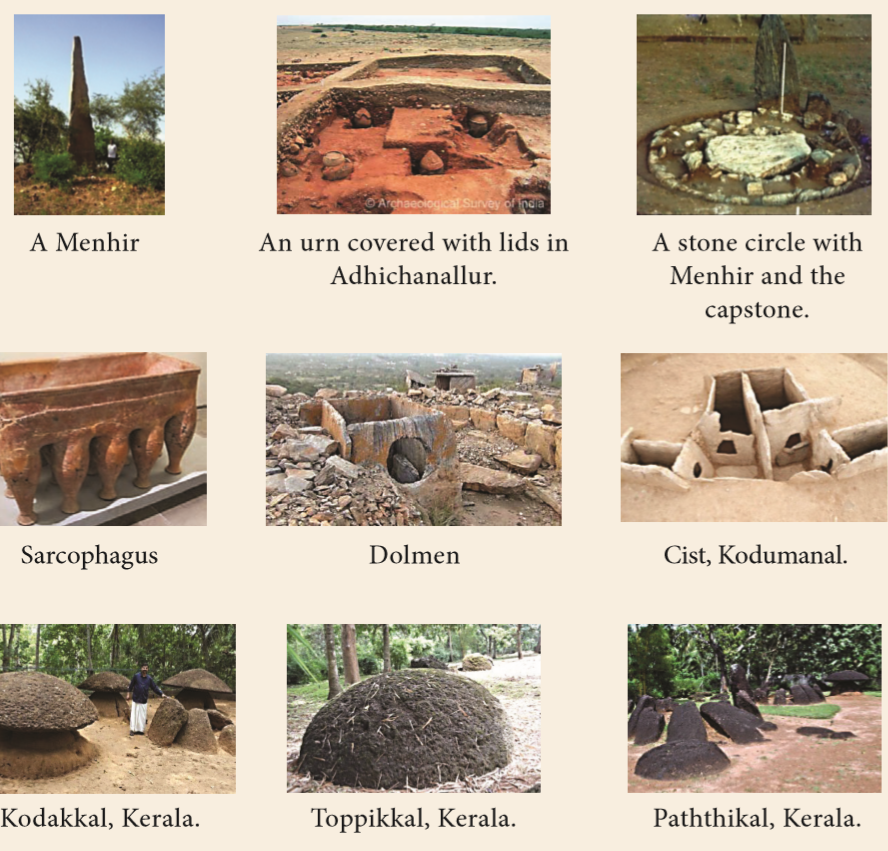
- The Iron Age is also known as megalithic, since people created burials with large stones for the dead people.
- Within these burials, the skeletons or a few bones of the dead persons were placed along with grave goods including iron objects, carnelian beads and bronze objects.
- Some of the burials do not have human bones and they have only the grave goods. They may be called memorial burials.
- Grave goods are the objects placed in the burials along with the physical remains (bones) of the dead. People may have believed that these would be useful in the after-life.
- Egyptian pyramids also have similar artefacts. Similar burials were also built in the early historic period or the Sangam Age.
- The Sangam literature mentions the various burial practices of the people. The megalithic burials are classified as dolmens, cists, menhirs, rock-cut caves, urn burials and sarcophagus.
- The burial types of Kodakkal (umbrella stone), Toppikkal (hatstone) and Paththikal (hoodstone) are found in Kerala.
- Dolmens, table-like stone structures, were erected as funerary monuments. Cists are stone enclosures buried under the earth.
- They were created by placing four stone slabs on the sides, one on top of each other. The cists and dolmens have openings called portholes. Urns are pottery jars and were used for burying the dead.
- Sarcophagi are burial receptacles made of terracotta. They sometimes had multiple legs.
- Menhirs are pillar-like stones erected as part of the burials or memorials. Portholes are holes found in the cists and dolmens on one side.
- They may have acted as the entrance to the burials. There is a view that they were meant for the movement of the soul or spirit.
- There could be several factors influencing the megalithic burial types. For example, social status or the importance of the individuals buried or simply the choice of the relatives of the dead could have been the reasons.
- Raw material availability is another reason. In the deltaic areas where stones are not available, people used the simple urns made by potters using clay.
- The menhirs may have been erected for the heroes in the Iron Age. The tradition of hero stones might have begun in the Iron Age or even before.
Agriculture and Pastoralism
- The people in the Iron Age practiced agriculture, domesticated cattle and sheep, and some of the groups were still hunting and gathering.
- Millets and rice were cultivated. Irrigation management developed in this period, since many of the megalithic sites are found nearby rivers and tanks.
- In the deltaic regions, irrigation as a technology had developed. Evidence of rice is seen in the megalithic sites like Adhichanallur in Thoothukudi district and Porunthal near Palani.
Iron Age Society and Polity
- The Iron Age society had farming communities, pastoralists and huntergatherers.
- Craft specialists, potters and blacksmiths were the professionals during this period. The society had several groups of peoples (tribes).
- The size of the burials and the variations found in the burial goods suggests the existence of numerous social groups and their diverse practices.
- Some of them seem to have had organised chiefdoms. Cattle lifting leading to wars and encroachment and expansion of territories had also started taking place in this period.
- Chiefdoms were stratified societies in which chiefs were selected based on kinship relations.
- The Ashokan inscriptions datable to third century BCE refers to the Cheras, Cholas, Pandyas and Satyaputras outside his empire in Tamilagam.
- If the Cheras, Cholas, Pandyas and Satyaputras had been powerful political powers in the Mauryan period, they must have commenced their political rule in the Iron Age.
Pottery
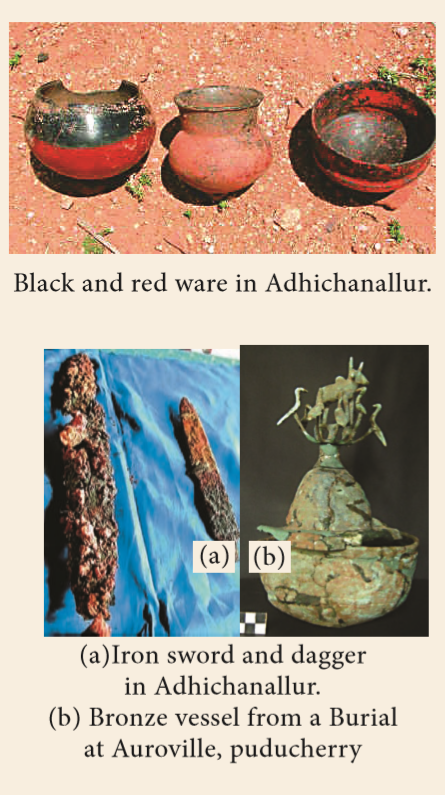
- Pottery is an important evidence found in the archaeological sites.
- The Iron Age and Sangam age people used the black and red colours to make black ware and red ware pottery.
- Potteries were used for cooking, storage and dining purposes. The black and red ware pottery has a black inside and a red outside, with lustrous surfaces.
Iron Technology and Metal Tools
- The megalithic burials have abundant iron objects placed in the burials as grave goods.
- Weapons such as swords and daggers, axes, chisels, lamps and tripod stands are also found.
- Some of these objects were hafted to wooden or bone or horn handles and used.
- The iron tools were used for agriculture, hunting, gathering and in battles.
- Bronze bowls, vessels with stylish finials decorated with animals and birds, bronze mirrors and bells have also been found.
More to Know:
1. Prehistoric period does not have evidence of writing.
2. Neolithic people perhaps devised the first pottery. They made pottery, using a slow wheel called turn-table or made pottery out of hand. Before firing, the pottery was polished with pebbles. This process is known as burnishing.
3. Athirampakkam and Gudiyam Cave yielded both Early and Middle Palaeolithic artefacts.
4. Wheat, barley and peas were domesticated around 10,000 years ago. Fruit and nut trees were domesticated around 4,000 BCE. They comprised olives, figs, dates, pomegranates and grapes.
5. The chimpanzee and the pygmy chimpanzee (also known as bonobo) are our closest living relatives.
6. The DNA of a chimpanzee is 98% identical to that of a human being.